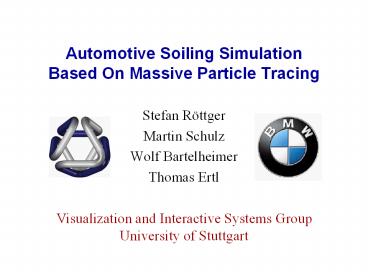Automotive Soiling Simulation Based On Massive Particle Tracing - PowerPoint PPT Presentation
Title:
Automotive Soiling Simulation Based On Massive Particle Tracing
Description:
Title: Kein Folientitel Author: Klasse Grafik Design Last modified by: VIS IFI Created Date: 5/10/2001 7:26:59 AM Document presentation format: Bildschirmpr sentation – PowerPoint PPT presentation
Number of Views:54
Avg rating:3.0/5.0
Title: Automotive Soiling Simulation Based On Massive Particle Tracing
1
Automotive Soiling SimulationBased On Massive
Particle Tracing
- Stefan Röttger
- Martin Schulz
- Wolf Bartelheimer
- Thomas Ertl
- Visualization and Interactive Systems Group
University of Stuttgart
2
Introduction
- Where did we start?
- Lattice-Boltzmann CFD solver (PowerFlow) used at
BMW - Hierarchical cartesian grids
- Fast tri-linear interpolation
3
Standard Flow Visualization Tools
- Interactive and immersive navigation in virtual
windtunnel - Stream lines
- Stream ribbons
- Glyphs
- Cutting planes
4
Goals
- What did we want?
- Massive particles for simulation of dust
particles - Interactively animated particles for more
intuitive flow visualization - Automotive soiling simulation
5
Massive Particles
- Each particle is treated as ideal sphere with
specific mass, diameter and initial position and
velocity - Particle drag, gravity and electrostatic forces
affect acceleration of particles - Stokes approximation of the drag is not good
enough - Particle drag in the flow is approximated by the
formula of OSeen for low Reynolds numbers
6
Massive Particle Tracing
- Second order differential equations
a(t)gtv(t)gtx(t) - Adaptive, embedded Runge-Kutta tracer of order
4(3) - Below 3 µm the differential equations are
becoming stiff, but then massive and massless
particle tracing is almost equivalent gt no
soiling - Average dust particle diameter in real world
evalutions is 5 to 500 µm
7
Animated Massive Particles
- Define emitters that generate particles at a
certain frequency - Emitters can be sized and positioned
interactively - Initial parameters of particles are assigned
stochastically - Particle stream is traced and displayed step by
step - The stream is displayed in slow motion at a given
target frame rate - Camera exposure model gt particles leave short
traces
8
Animated Massive Particles
- Intuitive visualization analogue to smoke probes
- Simultaneous display of multiple particles
- Particle velocity is visible implicitly
- Better three-dimensional impression due to
animation - Life time is color coded
9
Automotive Soiling Simulation
- Stochastically generate and trace massive
particles - Check for collision with the 70,000 surface
triangles by utilizing an octree - Color the hit points on the car body (nearest
mesh vertex) - Color code the number of hits on the surface
(blue no hits)
10
Simulation Performance
- Hit probability is low
- Large number of particles
- Simulation can be parallelized efficiently (e.g.
64 CPU SGI Onyx) - On an SGI Octane with 2x250MHz MIPS R10K
approximately 1000 particles can be traced
simultaneously at 7 Hz - Scales well with CPUs
1 hour
3 hours
11
Simulation Quality
- Now using stationary flow fields (120M per time
step) - Turbulences are smoothed away in time averaged
flow fields and hit probability is reduced even
further - gt Instationary flow fields
- Electrostatic forces influence dust aggregation
as well
Stokes
OSeen
12
Conclusion
- Animated massive particle streams for intuitive
data set exploration - Massive particle tracing used to compute
automotive soiling simulation by employing
collision detection - Good coincidence with real world soiling
situation - More accurate simulations require instationary
flow fields and research about near surface
effects - Massive particle tracing can be applied to other
regions of interest like smog or droplet
distribution simulations
13
Discussion
Questions?































